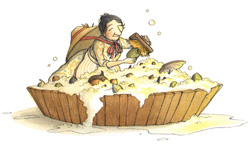 In Eliza Wheeler’s charming picturebook featured below, Miss Maple spends her time caring for orphan seeds. When they are ready to find their roots in the world, she sends them off with this powerful message: “Take care, my little ones, for the world is big and you are small. But never forget…even the grandest of trees once had to grow up from the smallest of seeds.” It is our hope that teachers will find the following collection of books useful for helping grow their students’ small seeds of understanding about gardens and savory foods into grand trees of knowledge.
In Eliza Wheeler’s charming picturebook featured below, Miss Maple spends her time caring for orphan seeds. When they are ready to find their roots in the world, she sends them off with this powerful message: “Take care, my little ones, for the world is big and you are small. But never forget…even the grandest of trees once had to grow up from the smallest of seeds.” It is our hope that teachers will find the following collection of books useful for helping grow their students’ small seeds of understanding about gardens and savory foods into grand trees of knowledge.
We hope you enjoy these book reviews from members of the International Reading Association's Children's Literature and Reading Special Interest Group (CL/R SIG).
GRADES K-3
Ancona, George. (2013). It’s our garden: From seeds to harvest in a school garden. New York, NY: Candlewick.
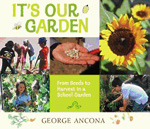 George Ancona’s compelling photo essay documents a year in the community garden at Acequia Madre Elementary School in Santa Fe, New Mexico. Here, children dash out the door to dig their hands in the soil when the recess bell rings. Punctuated with students’ drawings, vibrant photo spreads capture the children’s joy in planting, composting, and engaging in hands-on gardening techniques in their outdoor classroom. When class is not in session, children and community members continue to tend the garden and celebrate the savory fruits of their labor with music and vegetable-topped pizzas directly from the horno (oven) that the children constructed from bricks. Ancona integrates not only the spirit of healthy, multi-generational community building in this photo essay, but also a bounty of suggestions for supporting the school curriculum. This book is a must-have for any classroom that is interested in gardening and/or community projects.
George Ancona’s compelling photo essay documents a year in the community garden at Acequia Madre Elementary School in Santa Fe, New Mexico. Here, children dash out the door to dig their hands in the soil when the recess bell rings. Punctuated with students’ drawings, vibrant photo spreads capture the children’s joy in planting, composting, and engaging in hands-on gardening techniques in their outdoor classroom. When class is not in session, children and community members continue to tend the garden and celebrate the savory fruits of their labor with music and vegetable-topped pizzas directly from the horno (oven) that the children constructed from bricks. Ancona integrates not only the spirit of healthy, multi-generational community building in this photo essay, but also a bounty of suggestions for supporting the school curriculum. This book is a must-have for any classroom that is interested in gardening and/or community projects.
- Denise Dávila, The University of Georgia
Barner, Bob. (2013). I have a garden. New York, NY: Holiday House.
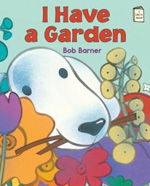 Part of Holiday House’s “I Like to Read” series of well-illustrated picturebooks for emergent readers, Barner’s cheerful white dog shows the reader on a repetitious tour through his garden, encountering the many other creatures who live there. However, the message at the end is simple—it is not just his garden but belongs to everyone who lives there. The short and choppy sentences geared for some of the earliest readers contrast with the colorful illustrations that seem deceptively straightforward. Instead, the pale outlines boldly distinguish nicely rounded shapes without adding a sharp edge to the story. The brightly saturated jewel tones that coat the garden appear flat but actually incorporate faint gradation to imply depth without the possibility of extra lines becoming a distraction to the novice reader. Choosing to keep the main character in white works extraordinarily well here, popping off the relatively dark pages engagingly.
Part of Holiday House’s “I Like to Read” series of well-illustrated picturebooks for emergent readers, Barner’s cheerful white dog shows the reader on a repetitious tour through his garden, encountering the many other creatures who live there. However, the message at the end is simple—it is not just his garden but belongs to everyone who lives there. The short and choppy sentences geared for some of the earliest readers contrast with the colorful illustrations that seem deceptively straightforward. Instead, the pale outlines boldly distinguish nicely rounded shapes without adding a sharp edge to the story. The brightly saturated jewel tones that coat the garden appear flat but actually incorporate faint gradation to imply depth without the possibility of extra lines becoming a distraction to the novice reader. Choosing to keep the main character in white works extraordinarily well here, popping off the relatively dark pages engagingly.
- Erin Reilly-Sanders, The Ohio State University
Fullerton, Alma. (2013). Community soup. Toronto, ON Canada: Pajama Press.
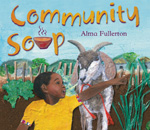 “It’s soup day!” The first line of this story draws readers into a day-in-the-life of Kenyan school community, which Fullerton depicts with mixed-media collage and paper-sculptures that lend a diorama-like depth to each scene. Readers who are familiar with tale of Stone Soup might see similarities in the way children Jomo, Dalila, Matu, and Amundi gather different vegetables from the community garden for the soup. Those familiar with the nursery rhyme Mary Had a Little Lamb will delight in the way Kioni’s herd of goats follows Kioni to school, despite the “No Goat” rule. In accessible prose, the two storylines merge for a happy ending. The final page of the book includes a recipe for vegetarian pumpkin vegetable soup with or without goat’s milk. A satisfying and worthy purchase, a portion of this book’s earnings goes to the Creation of Hope Project, which supports community gardens at Kenyan schools.
“It’s soup day!” The first line of this story draws readers into a day-in-the-life of Kenyan school community, which Fullerton depicts with mixed-media collage and paper-sculptures that lend a diorama-like depth to each scene. Readers who are familiar with tale of Stone Soup might see similarities in the way children Jomo, Dalila, Matu, and Amundi gather different vegetables from the community garden for the soup. Those familiar with the nursery rhyme Mary Had a Little Lamb will delight in the way Kioni’s herd of goats follows Kioni to school, despite the “No Goat” rule. In accessible prose, the two storylines merge for a happy ending. The final page of the book includes a recipe for vegetarian pumpkin vegetable soup with or without goat’s milk. A satisfying and worthy purchase, a portion of this book’s earnings goes to the Creation of Hope Project, which supports community gardens at Kenyan schools.
- Denise Dávila, The University of Georgia
Hayes, Joe. (2013). Don’t say a word, Mama/No digas nada, Mamá. El Paso, TX: Cinco Puntos Press.
 Rosa and Blanca have always been the best daughters and sisters in the world, says Mamá. So, when they grow up and have their own gardens, it’s not surprising that these sisters want to share their harvests. In the classic storytelling style of Joe Hayes, this modern folktale explores what happens when overly considerate sisters ask Mamá to keep a secret about something as hot as chiles, crisp as corn, and sweet as tomatoes. Richly illustrated in vibrant color, this positive family story also has visual zest. The double-spreads and dual language format makes for an inviting reading experience in both Spanish and English. Spread the word: Don’t Say A Word/ No Digas Nada, Mamá is a perfect addition to any classroom or library.
Rosa and Blanca have always been the best daughters and sisters in the world, says Mamá. So, when they grow up and have their own gardens, it’s not surprising that these sisters want to share their harvests. In the classic storytelling style of Joe Hayes, this modern folktale explores what happens when overly considerate sisters ask Mamá to keep a secret about something as hot as chiles, crisp as corn, and sweet as tomatoes. Richly illustrated in vibrant color, this positive family story also has visual zest. The double-spreads and dual language format makes for an inviting reading experience in both Spanish and English. Spread the word: Don’t Say A Word/ No Digas Nada, Mamá is a perfect addition to any classroom or library.
- Denise Dávila, The University of Georgia
Herrington, Lisa M. (2013). Tomatoes to ketchup. New York: Children’s Press/Scholastic.
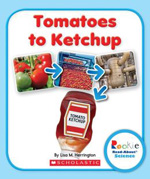 Kids will enjoy finding out how one of their favorite foods is made in this perfectly-sized easy reader. The graphic design keeps things simple with appealingly large photographs and the minimal sentences in black on a white page but adds enough interest to the book through side notes, bold headings, and extra facts that it feels fun an active. Plants and products are shown both with and without children and adults and give a good picture of the story behind a common condiment that is easy to take for granted. While great as an individual read, especially for readers who still need some help, this book could also prompt some interesting class explorations into tomato plants, tomatoes, commercial farming, manufacturing, and the other ingredients in the final product. Extra materials include a one-page overview of the process, glossary, and index. Other books in the Rookie Read-About Science series include Beans to Chocolate, Milk to Ice Cream, and Trees to Paper.
Kids will enjoy finding out how one of their favorite foods is made in this perfectly-sized easy reader. The graphic design keeps things simple with appealingly large photographs and the minimal sentences in black on a white page but adds enough interest to the book through side notes, bold headings, and extra facts that it feels fun an active. Plants and products are shown both with and without children and adults and give a good picture of the story behind a common condiment that is easy to take for granted. While great as an individual read, especially for readers who still need some help, this book could also prompt some interesting class explorations into tomato plants, tomatoes, commercial farming, manufacturing, and the other ingredients in the final product. Extra materials include a one-page overview of the process, glossary, and index. Other books in the Rookie Read-About Science series include Beans to Chocolate, Milk to Ice Cream, and Trees to Paper.
- Erin Reilly-Sanders, The Ohio State University
Kimmel, Eric A. (2013). Hanukkah Bear. New York: Holiday House.
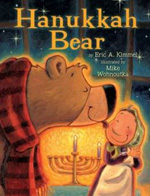 Eric Kimmel has revised The Chanukkah Guest, originally published in 1990 and winner of the Sydney Taylor Picture Book Award. With its new title and illustrations, as well as shorter text, readers can again experience Kimmel’s beloved story of Hanukkah. Old Bear wakes up from his winter sleep very hungry. He follows a delicious smell to the house of Bubba Brayna, who is preparing latkes for her annual Hanukkah celebration. The elderly cook mistakes Old Bear for the rabbi, so she entertains him with traditional Hanukkah food, games, and rituals. After eating all of the delicious potato latkes, the bear returns to his den and the guests arrive. They sort out the case of mistaken identity, and Bubba Brayna enlists their help to make more latkes. The book concludes with a recipe for latkes, as well as an author’s note about the festival of Hanukkah. Mike Wohnoutka’s colorful acrylic paintings are infused with light, perfect for bringing Kimmel’s story of the Jewish Festival of Lights to life. Read more about author Eric Kimmel in this "5 Questions With..." interview.
Eric Kimmel has revised The Chanukkah Guest, originally published in 1990 and winner of the Sydney Taylor Picture Book Award. With its new title and illustrations, as well as shorter text, readers can again experience Kimmel’s beloved story of Hanukkah. Old Bear wakes up from his winter sleep very hungry. He follows a delicious smell to the house of Bubba Brayna, who is preparing latkes for her annual Hanukkah celebration. The elderly cook mistakes Old Bear for the rabbi, so she entertains him with traditional Hanukkah food, games, and rituals. After eating all of the delicious potato latkes, the bear returns to his den and the guests arrive. They sort out the case of mistaken identity, and Bubba Brayna enlists their help to make more latkes. The book concludes with a recipe for latkes, as well as an author’s note about the festival of Hanukkah. Mike Wohnoutka’s colorful acrylic paintings are infused with light, perfect for bringing Kimmel’s story of the Jewish Festival of Lights to life. Read more about author Eric Kimmel in this "5 Questions With..." interview.
- Lisa Patrick, The Ohio State University at Marion
Kleven, Elisa. (2013). Glasswings: A butterfly’s story. New York: Dial Books for Young Readers/The Penguin Group.
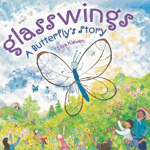 Elisa Kleven, a mixed media collage artist and storyteller, shares on her website that her collages and stories are about the “power of imagination to transform old into new, familiar into fantastical.” Her newest imaginative book tells the story of Claire, a Glasswing butterfly whose wings are clear as glass. One day, a gust of wind sweeps Claire away from her butterfly family and their home in the country among colorful flowers. The little butterfly finds herself lost in a big city; but luckily, she meets bird and insect friends who help her to find flowers in an empty city lot being tended by neighbors. Her family eventually finds her, joining Claire and her friends in their colorful urban garden. The book includes an author’s note on Glasswings and pollination. Readers can learn more about the book and view early sketches at Seven Impossible Things Before Breakfast’s interview with Elisa Kleven and at Kleven’s website.
Elisa Kleven, a mixed media collage artist and storyteller, shares on her website that her collages and stories are about the “power of imagination to transform old into new, familiar into fantastical.” Her newest imaginative book tells the story of Claire, a Glasswing butterfly whose wings are clear as glass. One day, a gust of wind sweeps Claire away from her butterfly family and their home in the country among colorful flowers. The little butterfly finds herself lost in a big city; but luckily, she meets bird and insect friends who help her to find flowers in an empty city lot being tended by neighbors. Her family eventually finds her, joining Claire and her friends in their colorful urban garden. The book includes an author’s note on Glasswings and pollination. Readers can learn more about the book and view early sketches at Seven Impossible Things Before Breakfast’s interview with Elisa Kleven and at Kleven’s website.
- Lisa Patrick, The Ohio State University at Marion
Lang, Elizabeth. (2013). In the garden. Mankato, MN: The Child’s World.
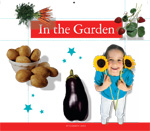 Elizabeth Lang takes young readers step-by-step through the process of planting a vegetable garden. She explains how plants need water, sunlight, and healthy soil in order to grow, even describing different types of soils and what makes the best soil for plants. Gardeners are advised to pay attention to the climate and types of seeds they are planting in certain weather, as well as the distance between plants. Blue inserts in every short chapter tell about the benefits of worms, historical uses for onions, and how to get rid of slugs. Captions give readers more details about how to compost, what kinds of tools will be necessary, or various vegetables. Lang even includes directions on how to make a wormery, a jar filled with sand and dirt, to learn how worms stir up the soil. This nonfiction picturebook would be nice for young readers who want to plant a garden.
Elizabeth Lang takes young readers step-by-step through the process of planting a vegetable garden. She explains how plants need water, sunlight, and healthy soil in order to grow, even describing different types of soils and what makes the best soil for plants. Gardeners are advised to pay attention to the climate and types of seeds they are planting in certain weather, as well as the distance between plants. Blue inserts in every short chapter tell about the benefits of worms, historical uses for onions, and how to get rid of slugs. Captions give readers more details about how to compost, what kinds of tools will be necessary, or various vegetables. Lang even includes directions on how to make a wormery, a jar filled with sand and dirt, to learn how worms stir up the soil. This nonfiction picturebook would be nice for young readers who want to plant a garden.
- Bettie Parsons Barger, The Ohio State University
Leedy, Loreen. (2013). Jack & the hungry giant: Eat right with MyPlate. New York: Holiday House.
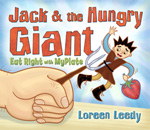 Jack’s mother is furious because he sold the cow for a handful of beans! The next morning, Jack climbs the beanstalk that grew overnight where Jack’s mother tossed the beans. As he explores the giant house he finds at the top of the beanstalk, Jack is terrified when he hears a giant! He tries to escape but the hungry giant catches him! Thankfully, the giant, Waldorf, is a kind one. Instead of eating Jack, he helps prepare a nutritious meal for Jack, Waldorf, and his wife, Zofia. Jack learns about the different food groups and how much of each should be on a healthy plate. Waldorf teaches him to limit the amount of added sugars and solid fats. Zofia teaches Jack how important it is to exercise as well. Overall, this provides an entertaining twist to the familiar tale, focusing on the importance of healthy eating and living.
Jack’s mother is furious because he sold the cow for a handful of beans! The next morning, Jack climbs the beanstalk that grew overnight where Jack’s mother tossed the beans. As he explores the giant house he finds at the top of the beanstalk, Jack is terrified when he hears a giant! He tries to escape but the hungry giant catches him! Thankfully, the giant, Waldorf, is a kind one. Instead of eating Jack, he helps prepare a nutritious meal for Jack, Waldorf, and his wife, Zofia. Jack learns about the different food groups and how much of each should be on a healthy plate. Waldorf teaches him to limit the amount of added sugars and solid fats. Zofia teaches Jack how important it is to exercise as well. Overall, this provides an entertaining twist to the familiar tale, focusing on the importance of healthy eating and living.
- Bettie Parsons Barger, The Ohio State University
Martin, Jacqueline Briggs. (2013). Farmer Will Allen and the growing table. Illus. by Eric-Shabazz Larkin. Bellevue, WA: Readers to Eaters.
 An inspiring non-fiction picturebook from the author of Snowflake Bentley, this book moves fresh produce from the farm to the city and then straight into the home or classroom. After introducing Will Allen and his vision, the story flashes back to Will’s childhood and his early hatred of farm work but love of the good food shared with family and friends. It follows Will briefly through his career playing basketball in Belgium and then a “white-shirt job” in Wisconsin before getting into issues of urban farming and Will’s work with Growing Power. The text is formatted as an engaging narrative punctuated by questions, dialog, and information. The illustrations add enthusiastic color mixed in bold patches and active linework to create lovely textured backgrounds that subtly become more saturated over the course of the story. The characters stand out as almost flat with cartoon-like simplicity that allows them to shift dynamically from page to page, creating an almost universal field of helping hands. Concluding with the motivational question, “How big will YOUR table be?” that turns the focus toward the reader, the book also includes a letter from Will, a couple photographs of his farm, an author’s note, and further resources.
An inspiring non-fiction picturebook from the author of Snowflake Bentley, this book moves fresh produce from the farm to the city and then straight into the home or classroom. After introducing Will Allen and his vision, the story flashes back to Will’s childhood and his early hatred of farm work but love of the good food shared with family and friends. It follows Will briefly through his career playing basketball in Belgium and then a “white-shirt job” in Wisconsin before getting into issues of urban farming and Will’s work with Growing Power. The text is formatted as an engaging narrative punctuated by questions, dialog, and information. The illustrations add enthusiastic color mixed in bold patches and active linework to create lovely textured backgrounds that subtly become more saturated over the course of the story. The characters stand out as almost flat with cartoon-like simplicity that allows them to shift dynamically from page to page, creating an almost universal field of helping hands. Concluding with the motivational question, “How big will YOUR table be?” that turns the focus toward the reader, the book also includes a letter from Will, a couple photographs of his farm, an author’s note, and further resources.
- Erin Reilly-Sanders, The Ohio State University
McCully, Emily Arnold. (2013). Pete won't eat. New York: Holiday House.
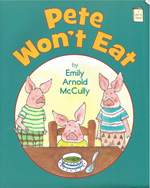 In this charming tale, Pete is not going to eat the green slop he is served. His siblings slurp theirs down and head outside to play while Pete is forced to stay at the table until he eats. Sounds of delight come through the window as Pete watches his siblings, sad that he is not there. Pete's mother frets over her decision to keep Pete in his seat until he eats and finally decides to make Pete something else. As she is making him a sandwich, Pete finally tries the green slop and finds that he loves it! The closing image is of Pete making green slop with his mom the very next day. McCully's lively illustrations, paired with her short text, make this a great discussion starter for young readers. What have you tried that was more delicious than you thought?
In this charming tale, Pete is not going to eat the green slop he is served. His siblings slurp theirs down and head outside to play while Pete is forced to stay at the table until he eats. Sounds of delight come through the window as Pete watches his siblings, sad that he is not there. Pete's mother frets over her decision to keep Pete in his seat until he eats and finally decides to make Pete something else. As she is making him a sandwich, Pete finally tries the green slop and finds that he loves it! The closing image is of Pete making green slop with his mom the very next day. McCully's lively illustrations, paired with her short text, make this a great discussion starter for young readers. What have you tried that was more delicious than you thought?
- Bettie Parsons Barger, The Ohio State University
Miller, Pat Zietlow. (2013). Sophie’s squash. New York: Schwartz & Wade Books/Random House.
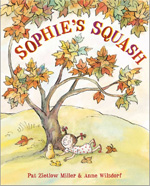 Well, Sophie has a new best friend. They met at a farmer’s market. Bernice likes to do the same things as Sophie. They somersault down the hill, listen to story time at the library, and frequent the farmer’s market. There is one major problem: Bernice is a squash! As Sophie’s parents try to convince her that Bernice was a squash, Bernice grows spots and becomes softer, even though Sophie is adamant that nothing is wrong. Eventually she realizes that Bernice is getting sick. A farmer explains that squash need “Fresh air. Good, clean dirt. A little love” to be healthy. Sophie makes a warm bed in the garden for Bernice and worries about her all winter. As spring comes, Bernice is reunited with Sophie, but she is different. This is a delightful story of a fast-friendship between Sophie and Bernice, along with the life cycle of a plant.
Well, Sophie has a new best friend. They met at a farmer’s market. Bernice likes to do the same things as Sophie. They somersault down the hill, listen to story time at the library, and frequent the farmer’s market. There is one major problem: Bernice is a squash! As Sophie’s parents try to convince her that Bernice was a squash, Bernice grows spots and becomes softer, even though Sophie is adamant that nothing is wrong. Eventually she realizes that Bernice is getting sick. A farmer explains that squash need “Fresh air. Good, clean dirt. A little love” to be healthy. Sophie makes a warm bed in the garden for Bernice and worries about her all winter. As spring comes, Bernice is reunited with Sophie, but she is different. This is a delightful story of a fast-friendship between Sophie and Bernice, along with the life cycle of a plant.
- Bettie Parsons Barger, The Ohio State University
Rhodes, Evan. (2013). Nature's super secrets: How do seeds sprout? New York: Gareth Stevens Publishing.
 In this simple text, Rhodes describes the lifecycle of a seed. Using close photographs, he explains to young readers how seeds planted in fertile soil need water and air to grow. Readers see tiny seeds, the insides of the sprouting seed, root growth and stem development as they turn the pages of this short text. Rich vocabulary words are written in bold, described in the text and defined in a glossary in the back. Rhodes also includes one page with six small images reiterating the lifecycle of a seed, helping readers recall the fact that they heard, or read, previously. This would be an excellent text to use with young readers learning how plants grow.
In this simple text, Rhodes describes the lifecycle of a seed. Using close photographs, he explains to young readers how seeds planted in fertile soil need water and air to grow. Readers see tiny seeds, the insides of the sprouting seed, root growth and stem development as they turn the pages of this short text. Rich vocabulary words are written in bold, described in the text and defined in a glossary in the back. Rhodes also includes one page with six small images reiterating the lifecycle of a seed, helping readers recall the fact that they heard, or read, previously. This would be an excellent text to use with young readers learning how plants grow.
- Bettie Parsons Barger, The Ohio State University
Rubin, Adam. (2013). Secret pizza party. New York: Dial Books for Young Readers/The Penguin Group.
 The creative team responsible for Dragons Love Tacos and Those Darn Squirrels! is back with a picturebook about Raccoon, who really, really loves pizza. Even his bedroom is decorated in a pizza theme, from his pizza-shaped lampshade to his colorful pizza bedspread. Raccoon makes repeated attempts to steal some pizza to eat. But all of his efforts are thwarted by people who chase him away with their brooms. The narrator of the story, who addresses Raccoon directly, takes pity on him and decides to throw him a secret pizza party. This party plan involves a clever disguise and a perfect getaway route. Secret Pizza Party is an entertaining postmodern picturebook for readers who enjoy stories that break the fourth wall between the reader and the audience. Daniel Salmieri’s watercolor, gouache, and color pencil artwork illustrates Raccoon’s hilarious antics. Readers may view Salmieri’s picturebook art, as well as art from his sketchbooks, at his website.
The creative team responsible for Dragons Love Tacos and Those Darn Squirrels! is back with a picturebook about Raccoon, who really, really loves pizza. Even his bedroom is decorated in a pizza theme, from his pizza-shaped lampshade to his colorful pizza bedspread. Raccoon makes repeated attempts to steal some pizza to eat. But all of his efforts are thwarted by people who chase him away with their brooms. The narrator of the story, who addresses Raccoon directly, takes pity on him and decides to throw him a secret pizza party. This party plan involves a clever disguise and a perfect getaway route. Secret Pizza Party is an entertaining postmodern picturebook for readers who enjoy stories that break the fourth wall between the reader and the audience. Daniel Salmieri’s watercolor, gouache, and color pencil artwork illustrates Raccoon’s hilarious antics. Readers may view Salmieri’s picturebook art, as well as art from his sketchbooks, at his website.
- Lisa Patrick, The Ohio State University at Marion
Sheth, Kashmira. (2013). Tiger in my soup. Atlanta, GA: Peachtree Publishers.
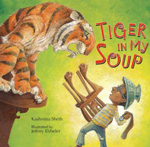 Tiger in my Soup is an entertaining sibling story about a bowl of soup that contains more than just soup. When his older sister is left in charge for the day, a young boy with a rich imagination tries to get her to read his tiger book to him. She ignores him until lunchtime, when she fixes him a bowl of hot alphabet soup. As the boy stirs his soup, a tiger rises up out of the steaming bowl and chases the boy all over the kitchen, his sister oblivious to the commotion. At the end of the story, she finally agrees to read the book to her brother, who reminds her to roar like a tiger. Ebbeler’s full-page acrylic paintings are alive with action and emotion. For example, he superimposes a tiger’s fierce face onto the sister’s roaring face. The peritext holds many creative details: The tiger book is pictured on the copyright page, and the endpapers show the tiger chasing the boy among cans of soup.
Tiger in my Soup is an entertaining sibling story about a bowl of soup that contains more than just soup. When his older sister is left in charge for the day, a young boy with a rich imagination tries to get her to read his tiger book to him. She ignores him until lunchtime, when she fixes him a bowl of hot alphabet soup. As the boy stirs his soup, a tiger rises up out of the steaming bowl and chases the boy all over the kitchen, his sister oblivious to the commotion. At the end of the story, she finally agrees to read the book to her brother, who reminds her to roar like a tiger. Ebbeler’s full-page acrylic paintings are alive with action and emotion. For example, he superimposes a tiger’s fierce face onto the sister’s roaring face. The peritext holds many creative details: The tiger book is pictured on the copyright page, and the endpapers show the tiger chasing the boy among cans of soup.
- Lisa Patrick, The Ohio State University at Marion
Tone, Satoe. (2013). The very big carrot. Grand Rapids, MI: Eerdmans Books for Young Readers.
 When six rabbits find a very big carrot, they ponder the possibilities of what to do with it until they find themselves hungry and looking for a very big meal. The story of this translation of a French picturebook is written as a series of questions, each answered with a supposition that trails off into its realization on the following page. Gorgeous illustrations charm to life the simple, swaying text. The soft colors that shift from blue green to yellows and oranges echo the tenderness of the rounded bodies of the rabbits. The pages are often strewn with the gentle textures of flowers and leaves. Perhaps a vestige of Tone’s Japanese roots, the whimsical nature of the story and the enchanting illustrations are reminiscent of Hayao Miyazaki’s animations. Even the small size of this book is adorable with the large carrot falling off the edges of the long pages in order to focus in on the rabbits and their imaginative escapades.
When six rabbits find a very big carrot, they ponder the possibilities of what to do with it until they find themselves hungry and looking for a very big meal. The story of this translation of a French picturebook is written as a series of questions, each answered with a supposition that trails off into its realization on the following page. Gorgeous illustrations charm to life the simple, swaying text. The soft colors that shift from blue green to yellows and oranges echo the tenderness of the rounded bodies of the rabbits. The pages are often strewn with the gentle textures of flowers and leaves. Perhaps a vestige of Tone’s Japanese roots, the whimsical nature of the story and the enchanting illustrations are reminiscent of Hayao Miyazaki’s animations. Even the small size of this book is adorable with the large carrot falling off the edges of the long pages in order to focus in on the rabbits and their imaginative escapades.
- Erin Reilly-Sanders, The Ohio State University
Trent, S. (2013). Farmers’ market day. Wilton, CT: Tiger Tales.
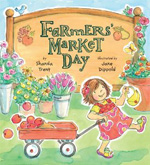 Early Saturday morning, a little girl clinks her piggy bank like an alarm clock to wake her mother and father. It’s farmer’s market day and she has big shopping plans for fruits, vegetable, and other delectables. With coffee in hand, red wagon in tow, and dog on leash, this story follows the family as they wind through stalls at the market filling their wagon and engaging with some vendors. This book’s two-page watercolor spreads could serve as a springboard for examining social narratives about who grows vegetables and fruit and who purchases these products at some farmers’ markets. At this market, for example, a man with brown skin tone and a guitar sells corn from the bed of an old truck. The family does not appear to purchase any of his corn. Nevertheless, they seem to buy something from nearly every other vendor. The subtext of this book’s illustrations merits critical consideration.
Early Saturday morning, a little girl clinks her piggy bank like an alarm clock to wake her mother and father. It’s farmer’s market day and she has big shopping plans for fruits, vegetable, and other delectables. With coffee in hand, red wagon in tow, and dog on leash, this story follows the family as they wind through stalls at the market filling their wagon and engaging with some vendors. This book’s two-page watercolor spreads could serve as a springboard for examining social narratives about who grows vegetables and fruit and who purchases these products at some farmers’ markets. At this market, for example, a man with brown skin tone and a guitar sells corn from the bed of an old truck. The family does not appear to purchase any of his corn. Nevertheless, they seem to buy something from nearly every other vendor. The subtext of this book’s illustrations merits critical consideration.
- Denise Dávila, The University of Georgia
Wheeler, Eliza. (2013). Miss Maple’s seeds. New York: Nancy Paulsen Books/The Penguin Group.
 Miss Maple’s Seeds, a New York Times Children’s Bestselling Picture Book, is the first book that Eliza Wheeler both wrote and illustrated. Miss Maple spends each summer looking for orphan seeds that were lost during spring planting. She brings them home to her maple tree, where she lovingly cares for each seed. Through fall and winter, Miss Maple nurtures the seeds and teaches them how to grow and bloom. Finally, on a windy morning in spring, Miss Maple sends her seeds out into the world, with this powerful message: “Take care, my little ones, for the world is big and you are small. But never forget…even the grandest of trees once had to grow up from the smallest of seeds.” This book would make a lovely graduation gift and a perfect end-of-the-school-year read aloud. The luminous art was created using dip pens, India ink and watercolors. Readers may visit Wheeler’s website to download coloring pages, view her artwork and portfolio, learn about upcoming projects, and follow links to interviews.
Miss Maple’s Seeds, a New York Times Children’s Bestselling Picture Book, is the first book that Eliza Wheeler both wrote and illustrated. Miss Maple spends each summer looking for orphan seeds that were lost during spring planting. She brings them home to her maple tree, where she lovingly cares for each seed. Through fall and winter, Miss Maple nurtures the seeds and teaches them how to grow and bloom. Finally, on a windy morning in spring, Miss Maple sends her seeds out into the world, with this powerful message: “Take care, my little ones, for the world is big and you are small. But never forget…even the grandest of trees once had to grow up from the smallest of seeds.” This book would make a lovely graduation gift and a perfect end-of-the-school-year read aloud. The luminous art was created using dip pens, India ink and watercolors. Readers may visit Wheeler’s website to download coloring pages, view her artwork and portfolio, learn about upcoming projects, and follow links to interviews.
- Lisa Patrick, The Ohio State University at Marion
GRADES 3-5
Spilsbury, Louise. (2014). How community gardens work. New York : Gareth Stevens Publishing.
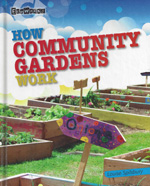 Don't let the size of this book fool you! Every page is filled with interesting information about community gardens. Starting with a little history of community gardens, dating back to Victory Gardens in World War II, Spilsbury describes the process of caring for community gardens, including the responsibilities and benefits of working in these gardens. Every page has wonderful photographs of people working in gardens, and many include interesting Eco-Facts that teach readers about pollination, bioremediation and composting. Readers become aware of the careful planning and tending gardens need in order to thrive. Spilsbury also hits on the health benefits working in a community garden can provide: physical exercise, healthier foods, especially organic foods, and nutrition awareness. Overall, this short book is filled to the brim with information, just ripe for the picking, in both the way it is written as well as presented.
Don't let the size of this book fool you! Every page is filled with interesting information about community gardens. Starting with a little history of community gardens, dating back to Victory Gardens in World War II, Spilsbury describes the process of caring for community gardens, including the responsibilities and benefits of working in these gardens. Every page has wonderful photographs of people working in gardens, and many include interesting Eco-Facts that teach readers about pollination, bioremediation and composting. Readers become aware of the careful planning and tending gardens need in order to thrive. Spilsbury also hits on the health benefits working in a community garden can provide: physical exercise, healthier foods, especially organic foods, and nutrition awareness. Overall, this short book is filled to the brim with information, just ripe for the picking, in both the way it is written as well as presented.
- Bettie Parsons Barger, The Ohio State University
Brunner-Jass, Renata. (2013). The garden club: Operations with fractions. Chicago, IL: Norwood House Press.
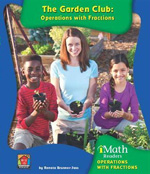 This is a dream come true for those planning a thematic unit on gardening. This text uses gardening as a jumping off point for a variety of fractions operations. Brunner-Jass begins with information about fractions, including terminology. There are activities for students to do as well as questions to foster discussion. She breaks down most every element of gardening using mathematical concepts. Students learn about dividing a plot equally among a variety of plants, especially among companion plants to eliminate pests. Interesting information, accompanied by photographs, is presented about animals that benefit gardens, like insects and chickens, as well as composting. All the while, Brunner-Jass incorporates questions and word problems. While this might not be a text a reader would pick up on his or her own, there are a number of benefits from using it to plan a unit! It is thorough, in-depth, and interesting.
This is a dream come true for those planning a thematic unit on gardening. This text uses gardening as a jumping off point for a variety of fractions operations. Brunner-Jass begins with information about fractions, including terminology. There are activities for students to do as well as questions to foster discussion. She breaks down most every element of gardening using mathematical concepts. Students learn about dividing a plot equally among a variety of plants, especially among companion plants to eliminate pests. Interesting information, accompanied by photographs, is presented about animals that benefit gardens, like insects and chickens, as well as composting. All the while, Brunner-Jass incorporates questions and word problems. While this might not be a text a reader would pick up on his or her own, there are a number of benefits from using it to plan a unit! It is thorough, in-depth, and interesting.
- Bettie Parsons Barger, The Ohio State University
GRADES 5-8
Bacigalupi, Paolo. (2013). Zombie baseball beatdown. New York, NY: Little, Brown and Company.
 This rousing tale of three friends, a fractured baseball team, and brain-eating zombie cows doesn’t fail to subtly unpack serious issues like food safety, immigration, racism, and privilege when something goes wrong at the local meat packing plant. Bacigalupi keeps the tone light and the plot focused on action as Rabi, Miguel, and Joe try to solve the mystery and prove to the oblivious adults that the corporation running Milgrow Meats presents a serious threat to food safety and human lives. In the meantime, while Rabi’s mathematical talents make him an engagingly brilliant strategist, his batting average could use some work. Bacigalupi’s newest book turns the corner from hypothetical futures to a real-life dystopia that exaggerates the issues in the meat industry. However, it easily manages to avoid becoming didactic with unique characters, zippy dialog, and a densely-stuffed action-adventure story perfect for middle grade readers.
This rousing tale of three friends, a fractured baseball team, and brain-eating zombie cows doesn’t fail to subtly unpack serious issues like food safety, immigration, racism, and privilege when something goes wrong at the local meat packing plant. Bacigalupi keeps the tone light and the plot focused on action as Rabi, Miguel, and Joe try to solve the mystery and prove to the oblivious adults that the corporation running Milgrow Meats presents a serious threat to food safety and human lives. In the meantime, while Rabi’s mathematical talents make him an engagingly brilliant strategist, his batting average could use some work. Bacigalupi’s newest book turns the corner from hypothetical futures to a real-life dystopia that exaggerates the issues in the meat industry. However, it easily manages to avoid becoming didactic with unique characters, zippy dialog, and a densely-stuffed action-adventure story perfect for middle grade readers.
- Erin Reilly-Sanders, The Ohio State University
Richardson, Gillian. (2013). 10 plants that shook the world. Illus. by Kim Rosen. Toronto, ON: Annick Press.
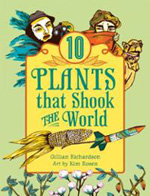 In 10 Plants that Shook the World, Gillian Richardson explores plants that have had a profound impact, both positive and negative, on our planet. In the book’s introduction, the author explains that these plants are often used with little consideration to their origin or the lives they have affected throughout history. Richardson remedies this lack of knowledge with an in-depth examination of the impact the plants have made on the world. Each of the ten chapters begins with a set of facts and statistics about the plant. Then a more detailed investigation of the plant’s evolution and its role in major historical, cultural, and political events is provided. A wide range of plants and their uses is covered: from plants we eat, to plants we wear, to plants we use for medicine. The book ends with a map of plant origins, a selected bibliography, a list of books for further reading, and an extensive index. Illustrator Kim Rosen provides the colorful artwork for the book.
In 10 Plants that Shook the World, Gillian Richardson explores plants that have had a profound impact, both positive and negative, on our planet. In the book’s introduction, the author explains that these plants are often used with little consideration to their origin or the lives they have affected throughout history. Richardson remedies this lack of knowledge with an in-depth examination of the impact the plants have made on the world. Each of the ten chapters begins with a set of facts and statistics about the plant. Then a more detailed investigation of the plant’s evolution and its role in major historical, cultural, and political events is provided. A wide range of plants and their uses is covered: from plants we eat, to plants we wear, to plants we use for medicine. The book ends with a map of plant origins, a selected bibliography, a list of books for further reading, and an extensive index. Illustrator Kim Rosen provides the colorful artwork for the book.
- Lisa Patrick, The Ohio State University at Marion
Tate, Nikki. (2013). Down to Earth: How kids help feed the world. Victoria, BC Canada: Orca Book Publishers.
 Connecting kids who may be more used to a supermarket than a farm with the production of their food is a challenge that Tate gamely takes on in Down to Earth. Photographs of children all over the world helping with both produce and livestock provides an important piece to the puzzle, as does the dense saturation of interesting facts and typically detailed captions. The book swings back and forth from the local scale, the author’s small farm on Vancouver Island, to global information and perspectives. The graphic design is attractive with natural-looking brown backgrounds at the beginning of chapters and pastel section headings, but the book presents almost too much information on one page for the reader to take in at once. With well-chosen variety of issues related to food—including genetic diversity, organic farming, food costs, sustenance, staple crops, multiple uses for livestock and their products, breeding, and marketing—the coverage of the book is vast, especially for only 48 pages. As a Canadian publication, the measurements in the book are presented in the metric system, which may present some minimal difficulty for American children.
Connecting kids who may be more used to a supermarket than a farm with the production of their food is a challenge that Tate gamely takes on in Down to Earth. Photographs of children all over the world helping with both produce and livestock provides an important piece to the puzzle, as does the dense saturation of interesting facts and typically detailed captions. The book swings back and forth from the local scale, the author’s small farm on Vancouver Island, to global information and perspectives. The graphic design is attractive with natural-looking brown backgrounds at the beginning of chapters and pastel section headings, but the book presents almost too much information on one page for the reader to take in at once. With well-chosen variety of issues related to food—including genetic diversity, organic farming, food costs, sustenance, staple crops, multiple uses for livestock and their products, breeding, and marketing—the coverage of the book is vast, especially for only 48 pages. As a Canadian publication, the measurements in the book are presented in the metric system, which may present some minimal difficulty for American children.
- Erin Reilly-Sanders, The Ohio State University
Wagner, Lisa. (2013). Cool world cooking: Fun and tasty recipes for kids!. Minneapolis: Scarletta.
 Experiencing the cuisines of different cultures is fun way to travel around the world and this book is an age-appropriate ticket to Mexico, France, Italy, Africa, the Middle East, China, and Japan. It starts basic with helpful rules for working in the kitchen and visual guides to tools and cooking terms. Each chapter introduces the ingredients of each region with a picture dictionary before moving into basic sides to accompany the recipes. The recipes are on an appropriately simple level but still maintain many of the trademark flavors of the specific country of its origin while also making sure to balance meals with vegetables, fruits, grains, and proteins. With a catchy cover and enticing graphic design, this book keeps things visual with maps, pictures of kids, and photographs that demonstrate the recipe step by step. The little extra bits of information on how food relates to each location really makes this book into a well-rounded cooking adventure.
Experiencing the cuisines of different cultures is fun way to travel around the world and this book is an age-appropriate ticket to Mexico, France, Italy, Africa, the Middle East, China, and Japan. It starts basic with helpful rules for working in the kitchen and visual guides to tools and cooking terms. Each chapter introduces the ingredients of each region with a picture dictionary before moving into basic sides to accompany the recipes. The recipes are on an appropriately simple level but still maintain many of the trademark flavors of the specific country of its origin while also making sure to balance meals with vegetables, fruits, grains, and proteins. With a catchy cover and enticing graphic design, this book keeps things visual with maps, pictures of kids, and photographs that demonstrate the recipe step by step. The little extra bits of information on how food relates to each location really makes this book into a well-rounded cooking adventure.
- Erin Reilly-Sanders, The Ohio State University
GRADES 9-12
Boffoli, Christopher. (2013). Big appetites: Tiny people in a world of big food. New York: Workman Publishing.
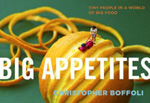 A photographic exhibition that combines both skill and wit, Boffoli’s imaginative food creations make a great crossover book from the adult world that teens won’t be able to help enjoying. Each of his fine art photographs features vivid food items on brightly colored background that are juxtaposed with tiny people inhabiting each unique scene. The graphic design is as big as the food, boldly filling each landscape-formatted page with the image and allowing the white text to float thoughtfully on colored background on the opposite side. The text in the book is minimal, and limited to a brief title and a sentence that humorously reflects on the image. While the pure amusement of an easy but sophisticated visual read shouldn’t be discounted, this book would find a great home in an art classroom as the seed for a still life photography project with the potential to comment meaningfully on people, society, and food.
A photographic exhibition that combines both skill and wit, Boffoli’s imaginative food creations make a great crossover book from the adult world that teens won’t be able to help enjoying. Each of his fine art photographs features vivid food items on brightly colored background that are juxtaposed with tiny people inhabiting each unique scene. The graphic design is as big as the food, boldly filling each landscape-formatted page with the image and allowing the white text to float thoughtfully on colored background on the opposite side. The text in the book is minimal, and limited to a brief title and a sentence that humorously reflects on the image. While the pure amusement of an easy but sophisticated visual read shouldn’t be discounted, this book would find a great home in an art classroom as the seed for a still life photography project with the potential to comment meaningfully on people, society, and food.
- Erin Reilly-Sanders, The Ohio State University
Knisley, Lucy. (2013). Relish: My life in the kitchen. New York: First Second Books.
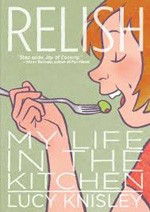 Lucy Knisley is a versatile artist, author, and musician. She is a comic artist, cartoonist, and puppet maker; an author and food/travel writer; and a singer, songwriter, and ukulele player. Knisley’s first published book is French Milk, a graphic journal about a six-week trip during which she and her mother ate their way through Paris. Her second book is Relish: My Life in the Kitchen, an engaging graphic memoir about growing up in the food industry. Knisley explores the evolution of her love for cooking and eating through words and art. From a childhood spent in her chef mother’s kitchen, to her art college years spent working at a gourmet food store in Chicago, Knisley’s life has been continuously immersed in food and cooking. The colorful artwork illustrates important memories and lessons she’s learned about food and life. Each chapter ends with a mouth-watering illustrated recipe. Readers may view Knisley’s comics, illustrations, and a range of other artistic endeavors on her extensive website.
Lucy Knisley is a versatile artist, author, and musician. She is a comic artist, cartoonist, and puppet maker; an author and food/travel writer; and a singer, songwriter, and ukulele player. Knisley’s first published book is French Milk, a graphic journal about a six-week trip during which she and her mother ate their way through Paris. Her second book is Relish: My Life in the Kitchen, an engaging graphic memoir about growing up in the food industry. Knisley explores the evolution of her love for cooking and eating through words and art. From a childhood spent in her chef mother’s kitchen, to her art college years spent working at a gourmet food store in Chicago, Knisley’s life has been continuously immersed in food and cooking. The colorful artwork illustrates important memories and lessons she’s learned about food and life. Each chapter ends with a mouth-watering illustrated recipe. Readers may view Knisley’s comics, illustrations, and a range of other artistic endeavors on her extensive website.
- Lisa Patrick, The Ohio State University at Marion
These reviews are submitted by members of the International Reading Association's Children's Literature and Reading Special Interest Group (CL/R SIG) and are published weekly on Reading Today Online. The International Reading Association partners with the National Council of Teachers of English and Verizon Thinkfinity to produce ReadWriteThink.org, a website devoted to providing literacy instruction and interactive resources for grades K–12.